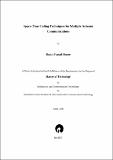| dc.contributor.advisor | Jadhav, Ashish | |
| dc.contributor.author | Shenoy, Shakti Prasad | |
| dc.date.accessioned | 2017-06-10T14:36:52Z | |
| dc.date.available | 2017-06-10T14:36:52Z | |
| dc.date.issued | 2004 | |
| dc.identifier.citation | Shenoy, Shakti Prasad (2004). Space-time coding techniques for multiple antenna communications. Dhirubhai Ambani Institute of Information and Communication Technology, viii, 41 p. (Acc.No: T00014) | |
| dc.identifier.uri | http://drsr.daiict.ac.in/handle/123456789/51 | |
| dc.description.abstract | Mobile communications has seen an explosive growth in the past decade. The reason for this growth can be traced to the increasing demand by the consumers for communication systems capable of exchanging information “anytime, anywhere” in the world. Rapid advances in semiconductor technology and signal processing techniques have led to the evolution of mobile communication devices from basic voice communication systems to those providing high quality data, image and multimedia services. One of the main requirements of next generation mobile communication standards therefore is provision for highly robust and reliable communication links for high data rate wireless services in a range of environments.
The presence of multiple scatterers in the mobile communication channel creates a multipath channel with time-varying fading characteristics. Traditionally, time and frequency diversity as well as spatial diversity techniques at the receiver have been used to combat the effect of multipath propagation. Recent research in channel coding over the less-studied transmit diversity techniques have led to a new class of channel codes for spatial diversity systems called space-time codes that exploit the multipath nature of the channel to provide enhanced link stability. Moreover these codes promise a phenomenal increase in throughput of the channel by using multiple antennas at the transmitter and the receiver. In this thesis we study the theory and practice of space-time coding techniques for multiple antenna communication systems. We discuss the information theoretic aspects of the so-called Multiple-Input-Multiple-Output (MIMO) channels and examine the various methods adopted for the design of space-time codes over such channels and their relative merits. We also carry out simulation to validate the claim that space-time codes can provide significant increase in SNR in multipath fading channels. | |
| dc.publisher | Dhirubhai Ambani Institute of Information and Communication Technology | |
| dc.subject | Antennas - propagation | |
| dc.subject | Mobile communication | |
| dc.subject | Mobile communication system | |
| dc.subject | MIMO | |
| dc.subject | Multiple input multiple output | |
| dc.subject | Space time coding techniques | |
| dc.classification.ddc | 621.3824 SHE | |
| dc.title | Space-time coding techniques for multiple antenna communications | |
| dc.type | Dissertation | |
| dc.degree | M. Tech | |
| dc.student.id | 200211021 | |
| dc.accession.number | T00014 | |

